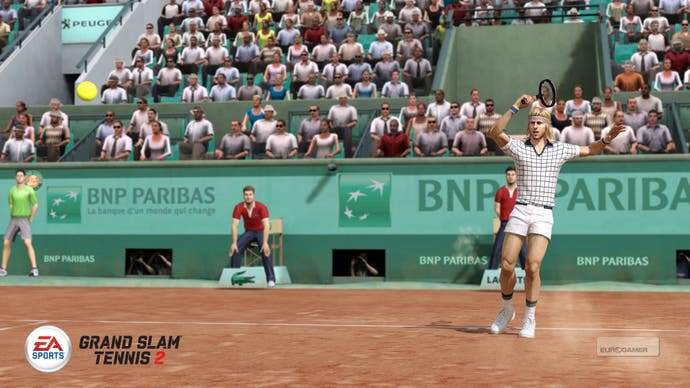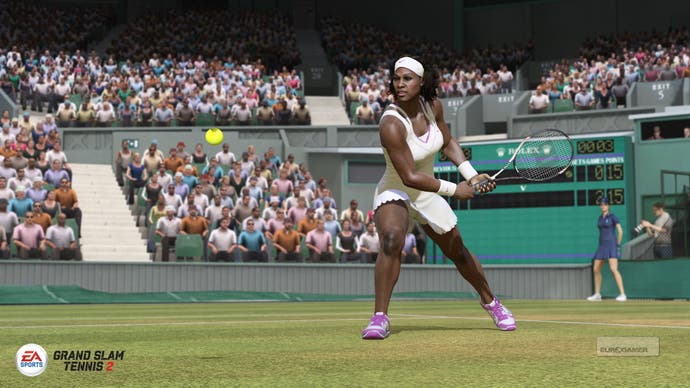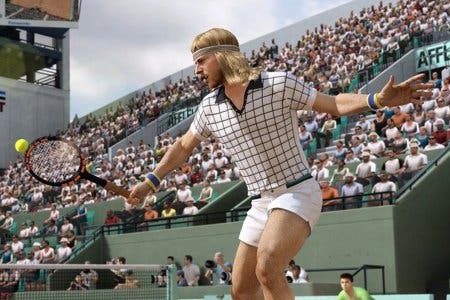Grand Slam Tennis 2 Review
Services rendered.
Making a new tennis game must be a daunting prospect given that two series have, like Novak Djokovic turning the screw on a flagging opponent, already got every angle covered. On one side of the court there's the zesty arcade brio of Virtua Tennis, with the controlled, sim-like approach of Top Spin on the other. Perhaps unsurprisingly, EA Sports has gone for something in between, but it's another sports game it most resembles.
Grand Slam Tennis might as well be called FIFA Tennis. It's a brand thing, and it's a bland thing, too - all crisp, sterile menus, ESPN swooshes bookending replays, tournament icons swooping in after every point, licensed players and stadia. But FIFA has been benefitting from its maker's iterative approach to sequels for years; formerly raw and unfocused, it's been tweaked and refined over the years into the well-oiled machine it is now. Grand Slam Tennis 2 has but a single predecessor, and that was a Wii game. Essentially, this is a debut all over again.
The first made a bit of a splash on Wii as the first title to support the original, unwieldy MotionPlus dongle, and it played a solid game, with acceptably precise motion controls and a caricatured look that was a perfect fit for its host console. Naturally, the visual style is more realistic here, but that serves only to highlight what's missing.

Player likenesses are generally very good, particularly when it comes to the classic characters like McEnroe and Borg. But there's not enough care in the animations. Sampras' loose-shouldered, almost simian posture while receiving is spot-on, yet his service action is robotic. Indeed, that's a persistent problem - Roddick's whip-crack serve slams down with a ferocity that no other player can match, but it'd be even more satisfying had his technique been properly replicated.
For a company that prides itself on verisimilitude, there are a number of glaring omissions. Where are Djokovic's elastic-limbed stretches, or Nadal's buggy-whip follow-through? The shrieks and grunts that accompany each shot might be authentic, but too often the animations - even when it comes to celebrations - are generic. There are exceptions, with Andy Murray proving appropriately inconsistent, thundering down double-fisted backhand returns and making far too many unforced errors.
If it often feels like you're facing reskins of the same two or three players, the on-court action all but proves it. Curiously, on the lower difficulty levels your opponents play more like the real thing, but in Pro and Superstar modes it seems everyone fancies themselves a serve-volleyer. Witnessing the likes of Murray and Nadal rushing forward on every rally is all the evidence you need to prove early suspicions that net play is overpowered.

Sure, a well-placed lob can do the trick, but getting enough distance to clear opponent but not baseline is an arcane art. CPU opponents on the higher difficulties have a knack of standing at the perfect spot to flick away cross-court volleyed winners while being able to scamper back for smashes that rarely miss. It doesn't help that your returns seem to arrow magnetically towards the centre of the court, even when you're trying your damnedest to power a passing shot down the line.
At least Grand Slam Tennis 2 attempts to match the furious pace of the real thing. There's a tendency to slow tennis games down to allow players to react - on the lower levels returns take a little longer to come back, but on Pro and Superstar difficulties the game moves at a satisfying lick.
Yet, if you're up to the challenge, it hobbles you in other ways. Because his groundstrokes are so powerful, EA has nerfed Nadal's movement. Dragging him around the court is like pushing a boulder downhill - the first few steps are a real struggle, but it's easier once you've picked up momentum.
When it comes to shot-making, EA Canada has included a number of options. Those familiar with existing tennis games might wish to start with the Arcade controls, where you can choose from a quick tap to return the ball with an average amount of force, or wind up for a more powerful stroke by holding the button and releasing when it reaches you.

Then you have the Total Racquet controls, which map strokes of all kinds to the right stick, the triggers acting as modifiers for lobs and drop shots. Though a bit of practice proves these to be surprisingly nuanced, it never feels entirely intuitive, particularly when you're moving around with the left stick. Still, you can switch between the two at will, perhaps using buttons to wind up a powerful flat stroke that sends your opponent scurrying to the back of the court before a delicate analogue flick executes the perfect cross-court drop shot.
And then there's Move. Sony's controller might look like it belongs on the shelves of Ann Summers, but it remains a wonderful piece of tech sadly missing the software support it deserves. Grand Slam Tennis 2 is a definite step in the right direction.
You're better off without the navigation controller at first, relying on the relatively reliable automated player movement so you can focus on getting your swing right. Move responds quickly and precisely. I always had a decent whipped topspin forehand in my locker, and using it to send Nole scampering back and forth before punching a backhand winner down the line - on Superstar difficulty - is one of the most satisfying moments I've experienced in a video game for some time.
It isn't perfect. Serving is particularly capricious, the camera occasionally failing to read your downswing until the timing line has passed the peak of the power meter - or, by contrast, imagining you've made an early swipe when you're simply holding Move aloft to toss the ball. During rallies, you can't move around too much, otherwise the controller will rumble to alert you that the camera can't see it (emitting a noisy buzz that underlines the tragedy of LucasArts going with Kinect for a Star Wars game).

Minor quibbles aside, Move support (there's no Kinect version) is comfortably the best thing about a game which offers little that its peers don't already have.
The Career mode is a 10-year pursuit of tennis glory with even less variety than Top Spin's similarly single-minded campaign; Sega remains streets ahead in this regard. Outside that, the standard Exhibition and Tournament modes are joined by ESPN Grand Slam classics, which dump you in famous matches and ask you to recreate or rewrite history. While fans of the sport will relish the opportunity to compete in the four Majors in the official arenas, the atmosphere is flat, hardly helped by the constant chunnering of Messrs McEnroe and Cash.
It would be wrong to call it commentary, as that would suggest some kind of interest in the events on court; instead the pair engage in a question-and-answer session on the basics of the game. Mac's so-called analysis is fairly inoffensive, though if I never hear about the pros and cons of hitting your shot deep ("the cons: none") it'll be too soon. But Cash's few observations on the game mainly involve him mocking your mistimed shots, which is the last thing you want to hear after losing a 35-shot rally on match point.
Still, EA's game has a few years on its rivals, and these are issues that can be ironed out in time. For now, however, the world number one spot remains tantalisingly out of reach. If Virtua Tennis is Nadal - bright, consistent, unafraid to work up a sweat - and Top Spin has the measured elegance of a Federer, Grand Slam Tennis is every bit the Andy Murray of tennis games: flashes of brilliance, prone to a few too many errors, but shows definite champion potential.

